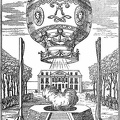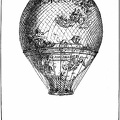This balloon was a truly scientific creation, which advanced aërostation from tottering infancy almost to full prime. The bag was a sphere 27½ feet in diameter made of gores of varnished silk. A net covered the upper half and was fastened to a horizontal hoop girding the middle of the globe, and called the “equator.” From the equator depended ropes which supported, just below the spherical bag, a wicker boat measuring eight feet by four, covered with painted linen and beautifully ornamented. The balloon had at the bottom a silk neck 7 inches in diameter, to admit the gas during inflation, and at the top, a valve which could be opened by means of a cord in the boat to let out gas during a voyage, so as to lower the balloon, or to relieve excessive pressure. In the boat were carried sand ballast to regulate the height of ascension, a barometer to measure the elevation, anchor and rope for landing, a thermometer, notebook, provisions, and all the paraphernalia of a scientific voyage. Barring the fancy boat, this is almost a description of a good modern balloon.
- Author
- Aërial Navigation
A Popular Treatise on the Growth of Air Craft and on Aëronautical Meteorology
By Albert Francis Zahm
Published in 1911
Available from gutenberg.org - Posted on
- Saturday 1 January 2022
- Dimensions
- 681*1050
- Tags
- Albums
- Technology / Transport / Air
- Visits
- 597
- Downloads
- 35
 Download Photo
Download Photo





